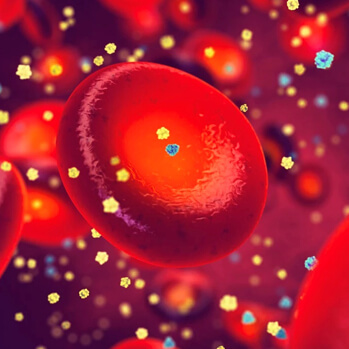The 5 Dangers Seborrheic Dermatitis
The more we’ve started to learn about seborrheic dermatitis, the more we’re realizing that its effects are not just limited to the skin. In fact, as more clinical data is coming in, it’s becoming clear that having seborrheic dermatitis can harm our body, our health and our life in many different ways.
Here are 5 dangers of seborrheic dermatitis that every sufferer should be aware of and do everything possible
to protect yourself from them:

It increases your chances of developing certain types of cancers
Recent evidence indicates that the Malassezia yeast that is behind seborrheic dermatitis may be carcinogenic and can increase your chances of developing Basal Cell Carcinoma. It is believed that this yeast produces potent molecules called AhR ligands that promote tumor growth.
Another way that Malassezia may cause cancer is through our body’s IgE antibody response. Research shows that the IgE antibody response to Malassezia is very strong during seborrheic dermatitis and these increased IgE levels also also amplify your risk of developing squamous cell carcinoma.
p>Studies done on organ transplant recipients also support this finding and show that seborrheic dermatitis is indeed “significantly associated” with squamous cell carcinoma.
A recent study published in the journal Nature has found a link between Malassezia and pancreatic cancer (pancreatic ductal adenocarcinoma) which has a 5-year survival rate of just 9%.
Demodex is a common parasite that is often found with dandruff in seborrheic dermatitis patients. According to one study study over 50% of seborrheic dermatitis sufferers have this parasite on their skin. What’s alarming is that this parasite is also commonly commonly found on damaged skin that is susceptible to non-melanoma skin cancer. That’s why your seborrheic dermatitis treatment should not only provide you with effective anti-cancer protection but also aim to clear a possible demodex infestation.
Finally, it is important to note that some seborrheic dermatitis treatments themselves can make you more likely to develop skin cancer. For example, antifungal shampoos and creams inhibit the production of ergosterol, a compound that acts as a natural sunscreen and absorbs harmful UV radiation. By depleting your skin’s ergosterol, antifungals increase UV damage to your skin cell DNA, further worsening your risk of developing skin cancer.

It can accelerate your aging process and may even affect your life expectancyIt increases your chances of
There’s growing evidence to show that both aging and most age-related diseases have one very important thing in common – inflammation. As we age, our body develops a certain type of low-level inflammation that is constantly present. This chronic, low-level, body-wide inflammation is known as inflammaging.
As the name suggests, not only does this kind of inflammation promote the aging process, it also causes progressive tissue damage and increases your chances of developing age-related diseases such as as cardiovascular disease, cancer, chronic kidney disease, dementia, disability in daily activities, muscle loss, frailty and even premature death.
One proposed mechanism by which seborrheic dermatitis can prematurely age you and even affect your life span is by worsening inflammaging. There is strong evidence to support the link between your skin health and inflammaging. For example, in an effort to fix the barrier dysfunction that your skin experiences during seborrheic dermatitis, it increases the production of pro-inflammatory cytokines which begin to accumulate in your blood Since seborrheic dermatitis is a chronic condition, your body is constantly exposed to these cytokines which continuously fuel inflammaging. This not only has a negative effect on your lifespan but can influence your health span as well.

It can cause mental and emotional health problems
According to one study, almost half of all seborrheic dermatitis patients experience severe emotional problems and the authors of the study emphasized how alarming the implications of these results were. These findings were further supported by another study that found psychiatric conditions to be “considerably frequent” in seborrheic dermatitis sufferers.
Indeed, other studies have confirmed the association between depression and seborrheic dermatitis. There is even evidence that people with seborrheic dermatitis are much more likely to suffer from higher stress and anxiety as compared to the general population.
It is important to note that this can have a dramatic impact on the sufferer’s overall life. For example, chronic stress has been linked to poor adrenal function which itself can lead to many issues such as fatigue, mental fogginess and poor sleep.
A large-scale study done on 2159 patients validated these findings and concluded that stress, depression and fatigue were all strongly associated with seborrheic dermatitis. In fact, this study showed that the severity of your seborrheic dermatitis symptoms is directly proportional to the severity of your anxiety and depression.
Now here’s what’s really interesting…
Until recently, many researchers believed that it was the mental and emotional problems that were causing a worsening of seborrheic dermatitis symptoms and not the other way around. In other words, they thought that your flareups were triggered when you were stressed, anxious or depressed. However, recent evidence shows that the opposite might also be true and it may very well be our seborrheic dermatitis that causes us to be stressed, anxious or depressed.
How?
Through something known as the gut-brain-skin axis.
As we saw earlier, our gut has significant influence over our skin’s health. A growing body of evidence now shows that our gut also strongly influences our brain and can cause mood disorders such as anxiety and depression.
In fact, there seems to be a a tri-directional communication between our gut, brain and skin with many overlapping inflammatory and immune mechanisms. This essentially means that the dysfunction our skin experiences during seborrheic dermatitis also has the ability to affect our mental and emotional health.

It is linked to an increased risk of developing metabolic disorders
Researchers have found that having seborrheic dermatitis is predictive of developing metabolic syndrome (MetS). Metabolic syndrome is a serious health condition that puts you at a higher risk of heart disease, strokes and diabetes.
While research into this condition is still in its infancy, what we’re learning is that people that develop metabolic syndrome have shorter life expectancies. According to one study, metabolic syndrome sufferers had a 22% higher mortality rate than people who didn’t have it. It is believed that chronic inflammation may be the initial trigger that sets off the long-term disease process of metabolic syndrome.
As we already know, seborrheic dermatitis not only causes skin inflammation but also increases your circulating levels of proinflammatory cytokines which can contribute to the low-level body-wide inflammation that is always present and become a factor in developing metabolic syndrome.
Other studies have supported these findings and have found that seborrheic dermatitis is linked to hyperinsulinism and insulin resistance, both of which are important risk markers for disease, disability and even a shorter lifespan.

It can affect your social life, work/academic life and your self-esteem
Multiple studies have shown that seborrheic dermatitis puts a huge psychosocial burden on the sufferer. There are many reasons for this. One of the main reasons being that seborrheic dermatitis is a disfiguring condition that affects highly visible areas of your body, constantly marring your appearance and striking you at the prime of your life.
What’s worse is that the disfigurement is not just limited to things like scaling skin and rash-like patches. There is even evidence now that seborrheic dermatitis can affect your appearance in other ways, such as:
Clinical evidence even shows that there is a very real social stigma surrounding seborrheic dermatitis. That’s because not only do people report finding it repellant, many incorrectly assume that the condition is either contagious or a result of poor hygiene. This can lead them to discriminate against the sufferer and show aversion towards them in social settings.
It’s no wonder that one of the largest studies done on the quality of life of seborrheic dermatitis sufferers found that almost half of all sufferers reported feeling embarrassed because of their condition.
Other studies have validated these findings and have found that seborrheic dermatitis can cause major self-esteem issues in people. This can lead the sufferer to altogether avoid social situations, leading to social isolation.
A recent in-depth study on the psychological and social impact of skin diseases found that conditions like seborrheic dermatitis can even negatively influence a person’s schooling, relationships, career choices and their ability to succeed in their career.
These 5 dangers show us that almost no part of the sufferer’s life remains untouched by the damaging effects of seborrheic dermatitis. It also tells us why it’s so important to treat the problem properly so that you not only find symptomatic relief but are also protected from all these long-term risks.
Unfortunately, this is where the currently available treatments fail us.
As you’re about to see next, most seborrheic dermatitis products have major drawbacks that make them ineffective and even dangerous for seborrheic dermatitis sufferers.
So, let’s take a look at 6 reasons why most seborrheic dermatitis treatments don’t work and what things you should watch out for when considering any particular product.


